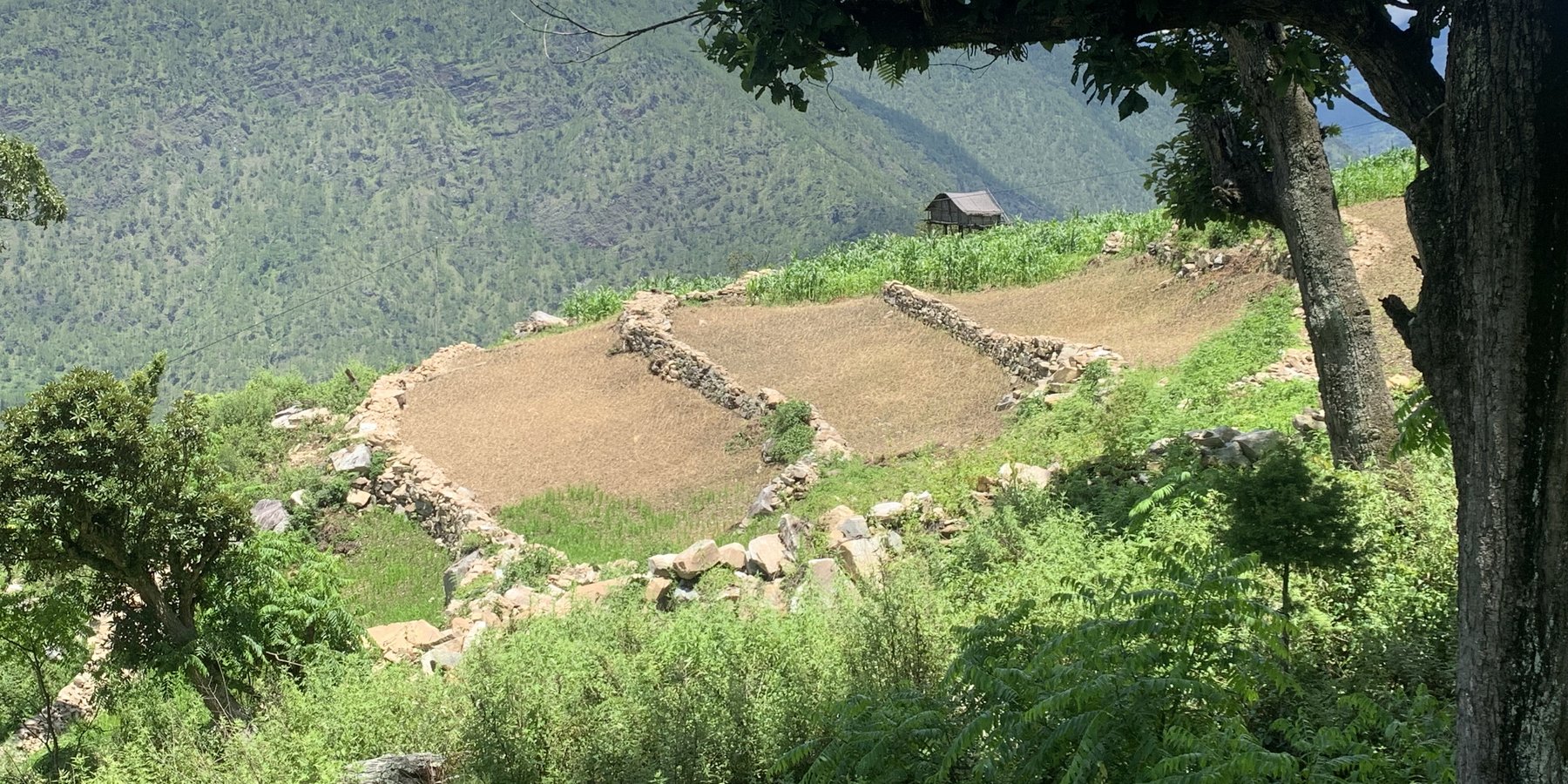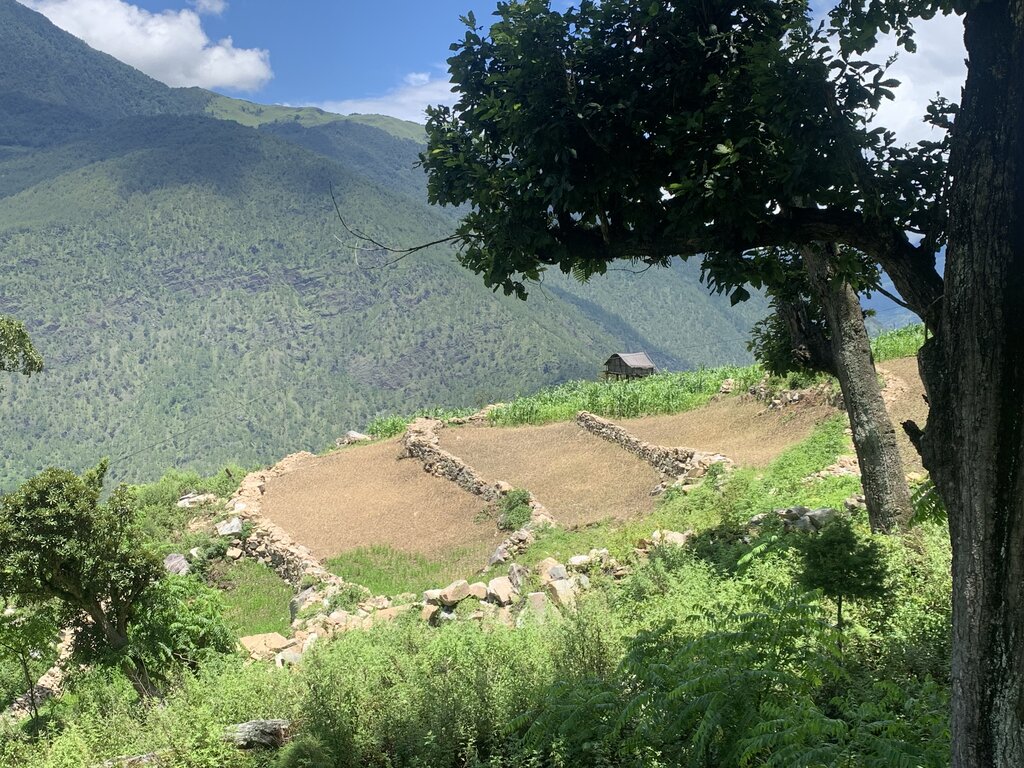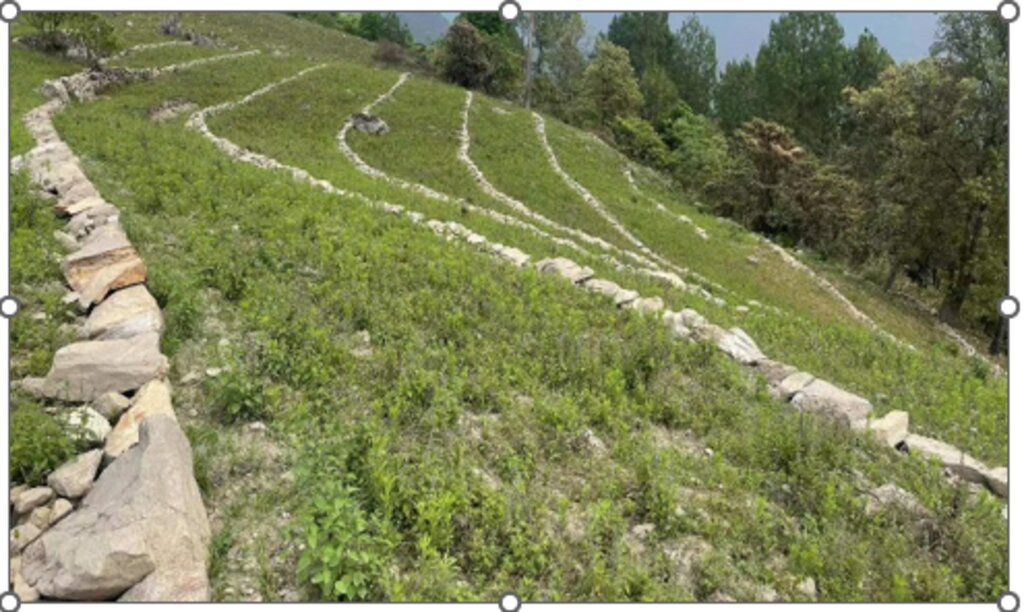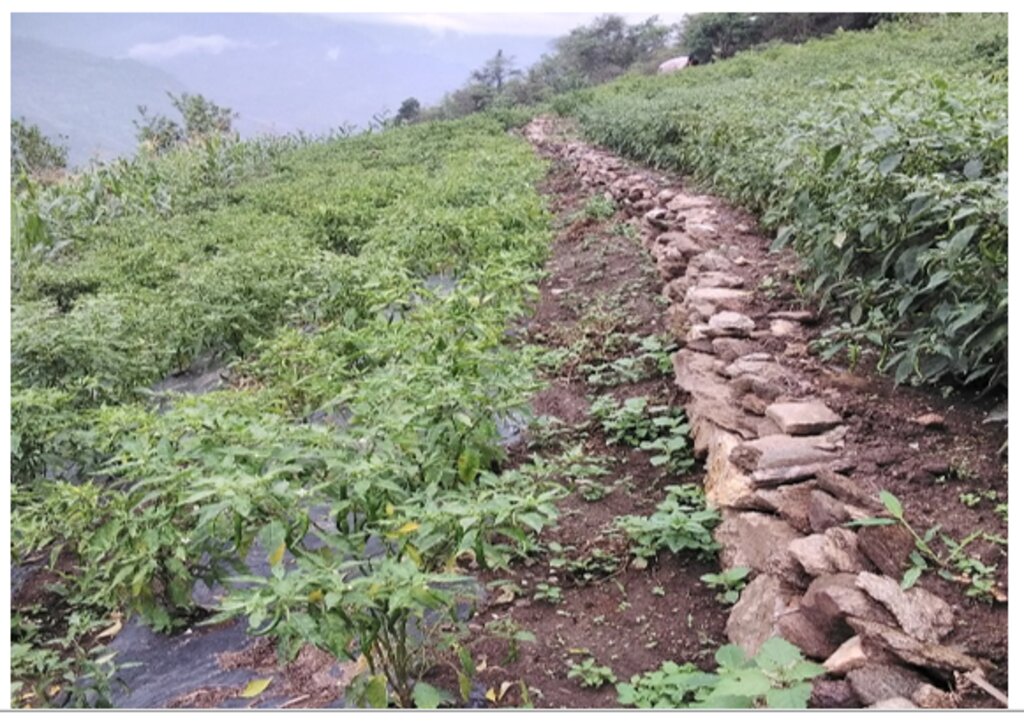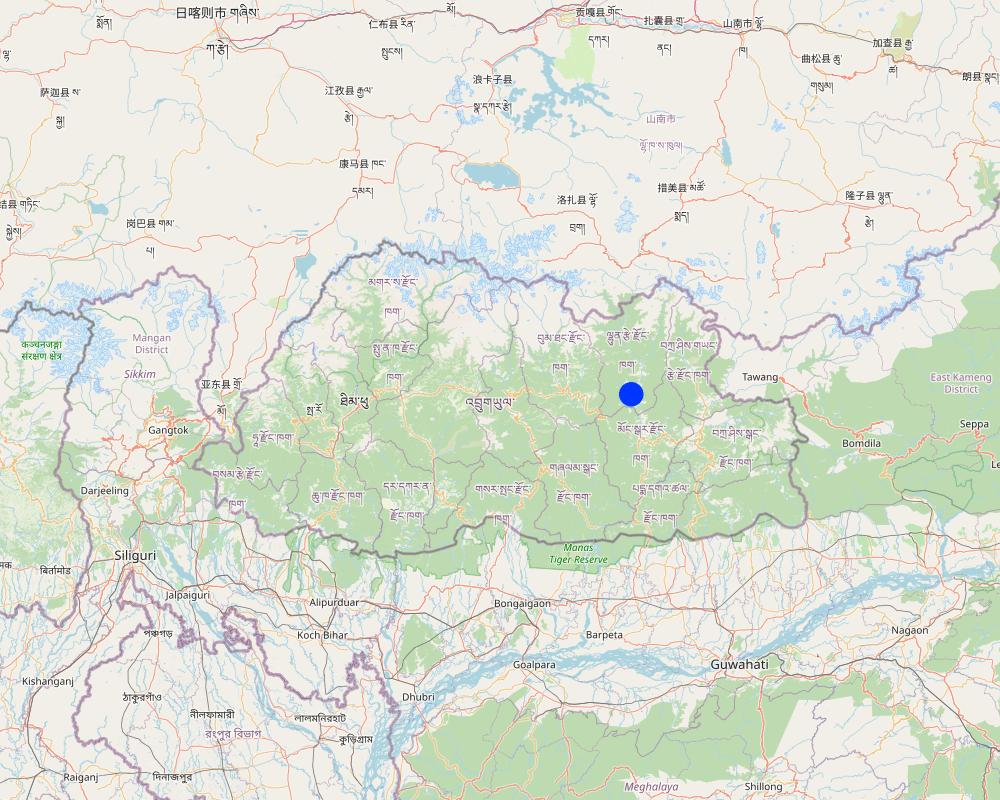Contour Stone Bunds [Bhoutan]
- Création :
- Mise à jour :
- Compilateur : Nima Dolma Tamang
- Rédacteur : Kuenzang Nima
- Examinateurs : William Critchley, Rima Mekdaschi Studer
རྡོའི་གད་ཚིགས།
technologies_6891 - Bhoutan
Voir les sections
Développer tout Réduire tout1. Informations générales
1.2 Coordonnées des personnes-ressources et des institutions impliquées dans l'évaluation et la documentation de la Technologie
Personne(s)-ressource(s) clé(s)
exploitant des terres:
Yangzom Pema
NA
Bhoutan
Nom du projet qui a facilité la documentation/ l'évaluation de la Technologie (si pertinent)
Strengthening national-level institutional and professional capacities of country Parties towards enhanced UNCCD monitoring and reporting – GEF 7 EA Umbrella II (GEF 7 UNCCD Enabling Activities_Umbrella II)Nom du ou des institutions qui ont facilité la documentation/ l'évaluation de la Technologie (si pertinent)
National Soil Services Centre, Department of Agriculture, Ministry of Agriculture & Livestock (NSSC) - Bhoutan1.3 Conditions relatives à l'utilisation par WOCAT des données documentées
Le compilateur et la(les) personne(s) ressource(s) acceptent les conditions relatives à l'utilisation par WOCAT des données documentées:
Oui
1.4 Déclaration sur la durabilité de la Technologie décrite
Est-ce que la Technologie décrite ici pose problème par rapport à la dégradation des terres, de telle sorte qu'elle ne peut pas être déclarée comme étant une technologie de gestion durable des terres?
Non
Commentaires:
The technology reduces soil erosion and conserves soil moisture
1.5 Référence au(x) Questionnaires sur les Approches de GDT (documentées au moyen de WOCAT)
2. Description de la Technologie de GDT
2.1 Courte description de la Technologie
Définition de la Technologie:
Contour stone bunding on sloping agricultural lands reduces soil erosion and conserves soil moisture in order to retain soil productivity. It is promoted /recommended on slopes where there is adequate surface stone.
2.2 Description détaillée de la Technologie
Description:
Contour stone bunds are small walls of stone that are laid out along the contour line to help reduce soil erosion, conserve soil moisture, increase soil fertility, to ease workability, increase cropping area, and ultimately ensure sustainable use of lands for enhanced food and nutrition security. This practice is recommended in fields that have plenty of surface stones (> 20%). Construction of contour stone bunds not only helps to get rid of the excess surface stones and gravel but also reduces the slope gradient through formation of partial terraces over a few years.
The stone bund is not new to Bhutan, being a mountainous country, forefathers used the technique to remove stones from the field and stabilise the land for agricultural purposes. Therefore, there were some traditional stone lines constructed in the study area.
Constructing stone bund is labour intensive, therefore land users resort to a labour sharing approach where all the land users from the community come together and work on a rotational basis until every household in the community has established stone bunds.
The major activities and inputs required to establish the contour stone bund includes sensitization of beneficiaries, followed by SLM action planning, and hands-on-training. Field implementation follows this sequence: (a) determination of intervals between stone bunds, (b) demarcation of contour lines using an ‘A’ frame, (c) digging a trench of 0.1 - 0.2 m deep and 0.5 m wide to establish a foundation along the contour lines, and (d) constructing stone lines along the trenches with the larger stones at the base to set a sound foundation. A typical stone wall is 0.3 m high (1 ft) and 0.3 - 0.5 m wide, but this depends on the slope and availability of stones in the field. Contour stone bunds are commonly spaced 6 metres apart on slopes of 60%. In some cases, the fodder grass slips are also planted at the base of the stone bund for better stabilization of the bunds and fodder availability.
The major drawbacks of this SLM technology according to respondents are (a) labour demanding, (b) no immediate return, and (c) the space between piled stones harbours rodents leading to crop damage.
2.3 Photos de la Technologie
2.5 Pays/ région/ lieux où la Technologie a été appliquée et qui sont couverts par cette évaluation
Pays:
Bhoutan
Région/ Etat/ Province:
Lhuentse Dzongkhag
Autres spécifications du lieu:
Zangkhar Village, Yabi-Zangkhar Chiwog, Jaray Gewog
Spécifiez la diffusion de la Technologie:
- répartie uniformément sur une zone
S'il n'existe pas d'informations exactes sur la superficie, indiquez les limites approximatives de la zone couverte:
- 0,1-1 km2
Est-ce que les sites dans lesquels la Technologie est appliquée sont situés dans des zones protégées en permanence?
Oui
Si oui, veuillez préciser:
The region where this SLM technology was implemented falls under Phrumsengla National Temperate Park. Phrumsengla National Park is a temperate park with large tracts of old-growth fir forests, its altitudes ranging from 700 metres (2,300 ft) to 4,400 metres (14,400 ft). Phrumsengla has scenic views, including forests ranging with elevations from alpine to sub-tropical. Because the soil of Phrumsengla's biomes is particularly fragile, the land is unsuitable for logging or other development
Map
×2.6 Date de mise en œuvre de la Technologie
Indiquez l'année de mise en œuvre:
2015
2.7 Introduction de la Technologie
Spécifiez comment la Technologie a été introduite: :
- par le biais de projets/ d'interventions extérieures
Commentaires (type de projet, etc.) :
The National Soil Service Center (NSSC), Semtokha, Thimphu initiated this activity as part of three-year (2015 to 2017) SLM project funded by Bhutan Trust Fund for Environmental Conservation (BTFEC).
3. Classification de la Technologie de GDT
3.1 Principal(aux) objectif(s) de la Technologie
- améliorer la production
- réduire, prévenir, restaurer les terres dégradées
- préserver l'écosystème
- s'adapter au changement et aux extrêmes climatiques et à leurs impacts
- créer un impact économique positif
3.2 Type(s) actuel(s) d'utilisation des terres, là où la Technologie est appliquée
Les divers types d'utilisation des terres au sein du même unité de terrain: :
Oui
Précisez l'utilisation mixte des terres (cultures/ pâturages/ arbres):
- Agroforesterie

Terres cultivées
- Cultures annuelles
- Cultures pérennes (non ligneuses)
Cultures annuelles - Précisez les cultures:
- plantes à racines et à tubercules - pommes de terre
- légumes - légumes à feuilles (laitues, choux, épinards, autres)
- Chili, cauliflower, cabbage, onion, brinjal and garlic.
- Peach, pear, fig, chayote
Nombre de période de croissance par an: :
- 2
Précisez:
Maize in summer is followed by cole crops in winter.
Est-ce que les cultures intercalaires sont pratiquées?
Oui
Si oui, précisez quelles cultures sont produites en culture intercalaire:
Brinjal, beans, onion and chayote.
Est-ce que la rotation des cultures est appliquée?
Oui
Si oui, veuillez préciser:
Maize cultivation followed by vegetables (cabbage)

Implantations, infrastructures
- Habitats, buildings
- Trafic: routes, réseaux ferroviaires
- Energie: pipelines, lignes haute tension
3.3 Est-ce que l’utilisation des terres a changé en raison de la mise en œuvre de la Technologie ?
Est-ce que l’utilisation des terres a changé en raison de la mise en œuvre de la Technologie ?
- Non (Passez à la question 3.4)
3.4 Approvisionnement en eau
Approvisionnement en eau des terres sur lesquelles est appliquée la Technologie:
- mixte: pluvial-irrigué
3.5 Groupe de GDT auquel appartient la Technologie
- mesures en travers de la pente
3.6 Mesures de GDT constituant la Technologie

pratiques végétales
- V2: Herbes et plantes herbacées pérennes

structures physiques
- S2: Diguettes, digues
Commentaires:
The technology also incudes vegetative measures where some land users plant fodder grass slips at the base of the stone bunds for better stabilization and fodder availability.
3.7 Principaux types de dégradation des terres traités par la Technologie

érosion hydrique des sols
- Wt: perte de la couche superficielle des sols (couche arable)/ érosion de surface
- Wg: ravinement/ érosion en ravines
- Wo: effets hors-site de la dégradation

dégradation biologique
- Bc: réduction de la couverture végétale
- Bq: baisse de la quantité/ biomasse
- Bs: baisse de la qualité et de la composition/ diversité des espèces
- Bp: augmentation des insectes nuisibles (ravageurs)/ maladies, baisse des prédateurs

dégradation hydrique
- Ha: aridification
3.8 Prévention, réduction de la dégradation ou réhabilitation des terres dégradées
Spécifiez l'objectif de la Technologie au regard de la dégradation des terres:
- réduire la dégradation des terres
- s'adapter à la dégradation des terres
4. Spécifications techniques, activités, intrants et coûts de mise en œuvre
4.1 Dessin technique de la Technologie
Spécifications techniques (associées au dessin technique):
The specifications provided in the technical drawing (NSSC, 2011) may vary based on the field situation and slope of the land. Variations may be in the width of the terrace (3 m to 6 m), the height of the stone bund (0.45 m to 1m), and minimal variations are observed in the width of the stone bund (0.6 m).
Auteur:
National Soil Service Centre
Date:
2011
4.2 Informations générales sur le calcul des intrants et des coûts
Spécifiez la manière dont les coûts et les intrants ont été calculés:
- par superficie de la Technologie
Indiquez la taille et l'unité de surface:
3 acres
autre/ monnaie nationale (précisez):
Nu
Indiquez le taux de change des USD en devise locale, le cas échéant (p.ex. 1 USD = 79.9 réal brésilien): 1 USD = :
80,0
Indiquez le coût salarial moyen de la main d'œuvre par jour:
400
4.3 Activités de mise en place/ d'établissement
| Activité | Calendrier des activités (saisonnier) | |
|---|---|---|
| 1. | Traditional stone bund construction | 50 years earlier |
| 2. | Sensitization, SLM action planning, and Hands-on-training | 2015 |
| 3. | Field implementation of the activity | 2015 |
| 4. | Provision of incentives (Nu. 3000 per acre) | 2015 |
| 5. | Project phase-off | 2017 |
| 6. | Scaling up of this technology through GEF-LDCF | 2022 |
Commentaires:
Traditionally stone bunds were constructed by forefathers during land preparation on the slopes. The stones were piled at the contour lines to make the soil workable and improve the gradient of the land.
4.4 Coûts et intrants nécessaires à la mise en place
| Spécifiez les intrants | Unité | Quantité | Coûts par unité | Coût total par intrant | % des coût supporté par les exploitants des terres | |
|---|---|---|---|---|---|---|
| Main d'œuvre | Labour | Person/day | 49,0 | 400,0 | 19600,0 | 100,0 |
| Autre | Project incentive | Per hectare | 1,0 | 6420,0 | 6420,0 | |
| Coût total de mise en place de la Technologie | 26020,0 | |||||
| Coût total de mise en place de la Technologie en dollars américains (USD) | 325,25 | |||||
Commentaires:
The costs and inputs needed for stone bund establishment are calculated for 1 hectare of land.
4.7 Facteurs les plus importants affectant les coûts
Décrivez les facteurs les plus importants affectant les coûts :
The most important factor affecting the cost is labor.
5. Environnement naturel et humain
5.1 Climat
Précipitations annuelles
- < 250 mm
- 251-500 mm
- 501-750 mm
- 751-1000 mm
- 1001-1500 mm
- 1501-2000 mm
- 2001-3000 mm
- 3001-4000 mm
- > 4000 mm
Spécifiez la pluviométrie moyenne annuelle (si connue), en mm:
1250,00
Spécifications/ commentaires sur les précipitations:
The rainfall received in the region may vary from 1000 to 1500 mm.
The rainfall data of the Gewog is not available. The area shares a border with the Medtsho Gewog and has similar agroecological zones. The data provided is for Medtsho Gewog.
Indiquez le nom de la station météorologique de référence considérée:
Website, Lhuentse Dzongkhag Administration
Zone agro-climatique
- subhumide
The Gewog falls under dry sub-tropical to warm temperate region (1500 to 2400 meters above sea level) from the six agroecological zones of Bhutan. It is characterized by extreme cold in winter and moderate in summer, humid and foggy.
5.2 Topographie
Pentes moyennes:
- plat (0-2 %)
- faible (3-5%)
- modéré (6-10%)
- onduleux (11-15%)
- vallonné (16-30%)
- raide (31-60%)
- très raide (>60%)
Reliefs:
- plateaux/ plaines
- crêtes
- flancs/ pentes de montagne
- flancs/ pentes de colline
- piémonts/ glacis (bas de pente)
- fonds de vallée/bas-fonds
Zones altitudinales:
- 0-100 m
- 101-500 m
- 501-1000 m
- 1001-1500 m
- 1501-2000 m
- 2001-2500 m
- 2501-3000 m
- 3001-4000 m
- > 4000 m
Indiquez si la Technologie est spécifiquement appliquée dans des:
- situations convexes
5.3 Sols
Profondeur moyenne du sol:
- très superficiel (0-20 cm)
- superficiel (21-50 cm)
- modérément profond (51-80 cm)
- profond (81-120 cm)
- très profond (>120 cm)
Texture du sol (de la couche arable):
- grossier/ léger (sablonneux)
Texture du sol (> 20 cm sous la surface):
- grossier/ léger (sablonneux)
Matière organique de la couche arable:
- faible (<1%)
Si disponible, joignez une description complète du sol ou précisez les informations disponibles, par ex., type de sol, pH/ acidité du sol, capacité d'échange cationique, azote, salinité, etc.
Moisture content 3.10%, organic matter 7.15%, Organic carbon 4.15%, pH 6.79, electrical conductivity 209.20 µs/cm, nitrogen 0.21%, phosphorus 1.00 ppm, Potassium 121.40 mg/100ml, texture loamy sand.
The soil analysis was conducted at the Science Laboratory of College of Natural Resources, Royal University of Bhutan, Lobesa, Punakha.
5.4 Disponibilité et qualité de l'eau
Disponibilité de l’eau de surface:
moyenne
Qualité de l’eau (non traitée):
eau potable
La qualité de l'eau fait référence à:
eaux souterraines
La salinité de l'eau est-elle un problème? :
Non
La zone est-elle inondée?
Non
5.5 Biodiversité
Diversité des espèces:
- élevé
Diversité des habitats:
- élevé
Commentaires et précisions supplémentaires sur la biodiversité:
The area is rich in species diversity as it has pockets of microclimate ensuring habitat diversity.
5.6 Caractéristiques des exploitants des terres appliquant la Technologie
Sédentaire ou nomade:
- Sédentaire
Orientation du système de production:
- exploitation mixte (de subsistance/ commerciale)
Revenus hors exploitation:
- moins de 10% de tous les revenus
Niveau relatif de richesse:
- moyen
Individus ou groupes:
- individu/ ménage
Niveau de mécanisation:
- travail manuel
- mécanisé/ motorisé
Genre:
- femmes
Age des exploitants des terres:
- personnes d'âge moyen
Indiquez toute autre caractéristique pertinente des exploitants des terres:
There are 11 Household members of which only the land user and her mother (86 years old) stay at home. Nine household members have migrated to the city for better opportunities.
5.7 Superficie moyenne des terres utilisées par les exploitants des terres appliquant la Technologie
- < 0,5 ha
- 0,5-1 ha
- 1-2 ha
- 2-5 ha
- 5-15 ha
- 15-50 ha
- 50-100 ha
- 100-500 ha
- 500-1 000 ha
- 1 000-10 000 ha
- > 10 000 ha
Cette superficie est-elle considérée comme de petite, moyenne ou grande dimension (en se référant au contexte local)?
- grande dimension
Commentaires:
The land user has 4 acres of land of which the technology is applied in 3 acres. The average land holding in Bhutan is 3.4 acres per household in 2021. Therefore, more than 3.4 acres are characterized as large-scale in the Bhutanese context.
5.8 Propriété foncière, droits d’utilisation des terres et de l'eau
- Family
Droits d’utilisation des terres:
- individuel
Droits d’utilisation de l’eau:
- accès libre (non organisé)
Est-ce que les droits d'utilisation des terres sont fondés sur un système juridique traditionnel?
Oui
5.9 Accès aux services et aux infrastructures
santé:
- pauvre
- modéré
- bonne
éducation:
- pauvre
- modéré
- bonne
assistance technique:
- pauvre
- modéré
- bonne
emploi (par ex. hors exploitation):
- pauvre
- modéré
- bonne
marchés:
- pauvre
- modéré
- bonne
énergie:
- pauvre
- modéré
- bonne
routes et transports:
- pauvre
- modéré
- bonne
eau potable et assainissement:
- pauvre
- modéré
- bonne
services financiers:
- pauvre
- modéré
- bonne
6. Impacts et conclusions
6.1 Impacts sur site que la Technologie a montrés
Impacts socio-économiques
Production
production agricole
Commentaires/ spécifiez:
The cultivation of potatoes increased due to an increase in the cultivable area as the stones are removed.
qualité des cultures
Commentaires/ spécifiez:
Crops appear greener and healthier due prevention of soil erosion as the topsoil is retained. Maize leaves were dark green and potatoes were bigger.
risque d'échec de la production
Commentaires/ spécifiez:
Due to the removal of stones from the soil, it is suitable for diverse crop growth (deep-rooted and shallow). Therefore, the land user can cultivate diverse crops throughout the year. Crop diversity and increased growing season will ensure land user with stable household income even if one crop fails.
diversité des produits
Commentaires/ spécifiez:
The technology reduces workload (mechanization) and increases cultivable area leading to the cultivation of diverse crops for market purposes.
surface de production
Commentaires/ spécifiez:
Increased due to the removal of stones from the land.
Revenus et coûts
dépenses pour les intrants agricoles
Commentaires/ spécifiez:
Expenses on agriculture input are reduced. For example, with the use of a power tiller which costs Nu. 1500 per day, it takes 2 days to complete ploughing. If it is done by oxen then it takes 8 days and Nu. 400 is paid as a labour charge per day. The total amount required using the power tiller is Nu. 3000 and using oxen is Nu. 3200 with an additional cost of food for the labourers.
revenus agricoles
Commentaires/ spécifiez:
Previously the land user was not able to meet the demand for maize as a feed for the cattle. With the introduction of stone bunding and increased production, the land user can meet her domestic demand for maize and additionally sell processed maize alcohol as a source of farm income.
diversité des sources de revenus
Commentaires/ spécifiez:
There is an increased diversity of income sources as the land user can grow different crops throughout the year and also sell some processed products.
charge de travail
Commentaires/ spécifiez:
Reduced work load due to farm mechanization. The removal of stone from field had eased workability, lesser wear and tear of farm tools.
Impacts socioculturels
sécurité alimentaire/ autosuffisance
Commentaires/ spécifiez:
With the increase in cultivable areas, technology has ensured food self-sufficiency and generated income to meet other household demands for food.
possibilités de loisirs
Commentaires/ spécifiez:
Reduced workload is directly related to an increase in the available time for recreational opportunities.
institutions nationales
Commentaires/ spécifiez:
Support provided by the NSSC and land users' active participation in the implementation of the technology enabled the national agency to have a better understanding of the land users. Labour sharing enabled the community to work together to achieve a common goal which improved collaboration among the community members.
connaissances sur la GDT/ dégradation des terres
Commentaires/ spécifiez:
Awareness was created during the introduction of the technology by SLM specialists. Further, the field observation on the neighbours' fields who have already established stone bunds has led to 90% of the population knowing about the stone bunding in the locality.
apaisement des conflits
Commentaires/ spécifiez:
Human-wildlife conflict was reduced as wild boars were not able to climb the stone bund. Although other wild animal such as procupine continued to cause harm to the crop.
situation des groupes socialement et économiquement désavantagés
Commentaires/ spécifiez:
The technology improved soil quality leading to improved production and increased household income.
Impacts écologiques
Sols
humidité du sol
Commentaires/ spécifiez:
The stone bund holds irrigation water preventing surface runoff. Further, the gradual labelling of the land increases soil moisture retention capacity.
couverture du sol
Commentaires/ spécifiez:
Increased due to crop diversification and year-round cultivation.
perte en sol
Commentaires/ spécifiez:
Soil erosion and surface runoff is reduced leading to decreased soil loss.
accumulation de sol
Commentaires/ spécifiez:
Eroded soil is accumulated at bunds.
matière organique du sol/ au dessous du sol C
Commentaires/ spécifiez:
Soil organic matter is decreased at the upper part of the terrace and increased at the lower part of the terrace due to runoff from the slopes.
Biodiversité: végétale, animale
Couverture végétale
Commentaires/ spécifiez:
Increased with the practice of year-round cultivation.
diversité végétale
Commentaires/ spécifiez:
The technology increased suitability of the soil for diverse crops increasing plant diversity.
contrôle des animaux nuisibles/ maladies
Commentaires/ spécifiez:
The better crop stand resists pest and diseases attacks on crops. To some extend, the stone bunds keep the wild boars away.
Réduction des risques de catastrophe et des risques climatiques
glissements de terrains/coulées de débris
Commentaires/ spécifiez:
Reduced surface runoff leads to decreased landslides or debris flow.
Précisez l'évaluation des impacts sur site (sous forme de mesures):
The impact percentage given in this section is a mixture of farmer and professional estimates.
6.2 Impacts hors site que la Technologie a montrés
Précisez l'évaluation des impacts extérieurs (sous forme de mesures):
No off-site impact of the technology is expected or measurable on this small scattered scale.
6.3 Exposition et sensibilité de la Technologie aux changements progressifs et aux évènements extrêmes/catastrophes liés au climat (telles que perçues par les exploitants des terres)
Changements climatiques progressifs
Changements climatiques progressifs
| Saison | Augmentation ou diminution | Comment la Technologie fait-elle face à cela? | |
|---|---|---|---|
| précipitations annuelles | augmente | pas bien |
Commentaires:
The technology does not cope well with increased annual rainfall as it loosens the foundation soil on which the stone wall is built leading to the collapsing of the stone wall.
6.4 Analyse coûts-bénéfices
Quels sont les bénéfices comparativement aux coûts de mise en place (du point de vue des exploitants des terres)?
Rentabilité à court terme:
positive
Rentabilité à long terme:
positive
Quels sont les bénéfices comparativement aux coûts d'entretien récurrents (du point de vue des exploitants des terres)?
Rentabilité à court terme:
très positive
Rentabilité à long terme:
très positive
Commentaires:
The benefits compared with the establishment costs for the short term are positive due to the subsidy provided.
6.5 Adoption de la Technologie
- > 50%
Si disponible, quantifiez (nombre de ménages et/ou superficie couverte):
Total of 33 households adopted stone bunds technology.
De tous ceux qui ont adopté la Technologie, combien d'entre eux l'ont fait spontanément, à savoir sans recevoir aucune incitation matérielle, ou aucune rémunération? :
- 0-10%
Commentaires:
All the households received incentive in the form of cash and machinery.
6.6 Adaptation
La Technologie a-t-elle été récemment modifiée pour s'adapter à l'évolution des conditions?
Non
6.7 Points forts/ avantages/ possibilités de la Technologie
| Points forts/ avantages/ possibilités du point de vue de l'exploitant des terres |
|---|
| Sloping land is challenged by soil erosion and it has a poor ability to retain water. This challenge was alleviated by stone bunding as it significantly reduced soil degradation. |
| The land user shared that there is an increased cultivable area after the implementation of the technology. Bigger stones were excavated and piled as stone bunds increasing the total area for cultivation. |
| The technology eased farming, as agronomic practices such as tilling became efficient due to the use of power tillers. Soil depth was increased leading to ease in weeding, bed making and other management practices. |
| Stone walls prevented wild boar from entering the field reducing crop loss. Therefore, the farmers need not guard the field from wild boar. |
| Increased cultivable area and easy working conditions of the soil lead to increased production, and improved livelihood of the farm household. |
| Points forts/ avantages/ possibilités du point de vue du compilateur ou d'une autre personne ressource clé |
|---|
| The technology contributed to reducing rural-urban migration and generated employment. Stone bunding indirectly helped the farming community to engage in agricultural activities and stay back in the village rather than going out to the city in search of employment. |
| Prevent natural disasters. The Gewog is located in the steep slopes and there is a risk of landslides leading to loss of agricultural land, property, and life. Stone bunding prevents surface runoff which could aggravate and lead to land slides. |
| Once the stone and boulders are removed and piled along contour line, it improves workability on the farm. |
6.8 Faiblesses/ inconvénients/ risques de la Technologie et moyens de les surmonter
| Faiblesses/ inconvénients/ risques du point de vue de l’exploitant des terres | Comment peuvent-ils être surmontés? |
|---|---|
| Construction of stone bunds is a laboursome and has no direct benefit to the land users. | Practice labour sharing working modality. |
| If stone bunds were not constructed properly, it could be easily damaged by cattle, washed or collapsed by heavy rainfall. | Proper piling of stones during the stone bund construction. |
| Faiblesses/ inconvénients/ risques du point de vue du compilateur ou d'une autre personne ressource clé | Comment peuvent-ils être surmontés? |
|---|---|
| Some sort of incentives is required to scale out the adoption of technology as its requires huge labour and time with no immediate benefits. | Incentive of Nu 3000 tied with construction of 1 ac of stone bunds |
7. Références et liens
7.1 Méthodes/ sources d'information
- visites de terrain, enquêtes sur le terrain
Three field visits was conducted
- interviews/entretiens avec les exploitants des terres
Randomly picked land user from the community for documentation. One land user was interviewed.
Quand les données ont-elles été compilées (sur le terrain)?
22/07/2023
7.2 Références des publications disponibles
Titre, auteur, année, ISBN:
NSSC. (2011). Bhutan catalogue of soil and water conservation approaches and technologies. National Soil Service Center (NSSC), Department of Agriculture, Ministry of Agriculture and Forests, Royal Government of Bhutan, Thimphu
Disponible à partir d'où? Coût?
Book and soft copy from https://www.wocat.net/documents/140/Bhutan_catalogue_of_SLM_Technologies_and_Approaches.pdf
7.3 Liens vers les informations pertinentes en ligne
Titre/ description:
Sustainable Land Management for improved land productivity & community livelihood in Thangrong
URL:
https://www.youtube.com/watch?v=-XS-qFv2dYQ
Liens et modules
Développer tout Réduire toutLiens
Aucun lien
Modules
Aucun module trouvé


